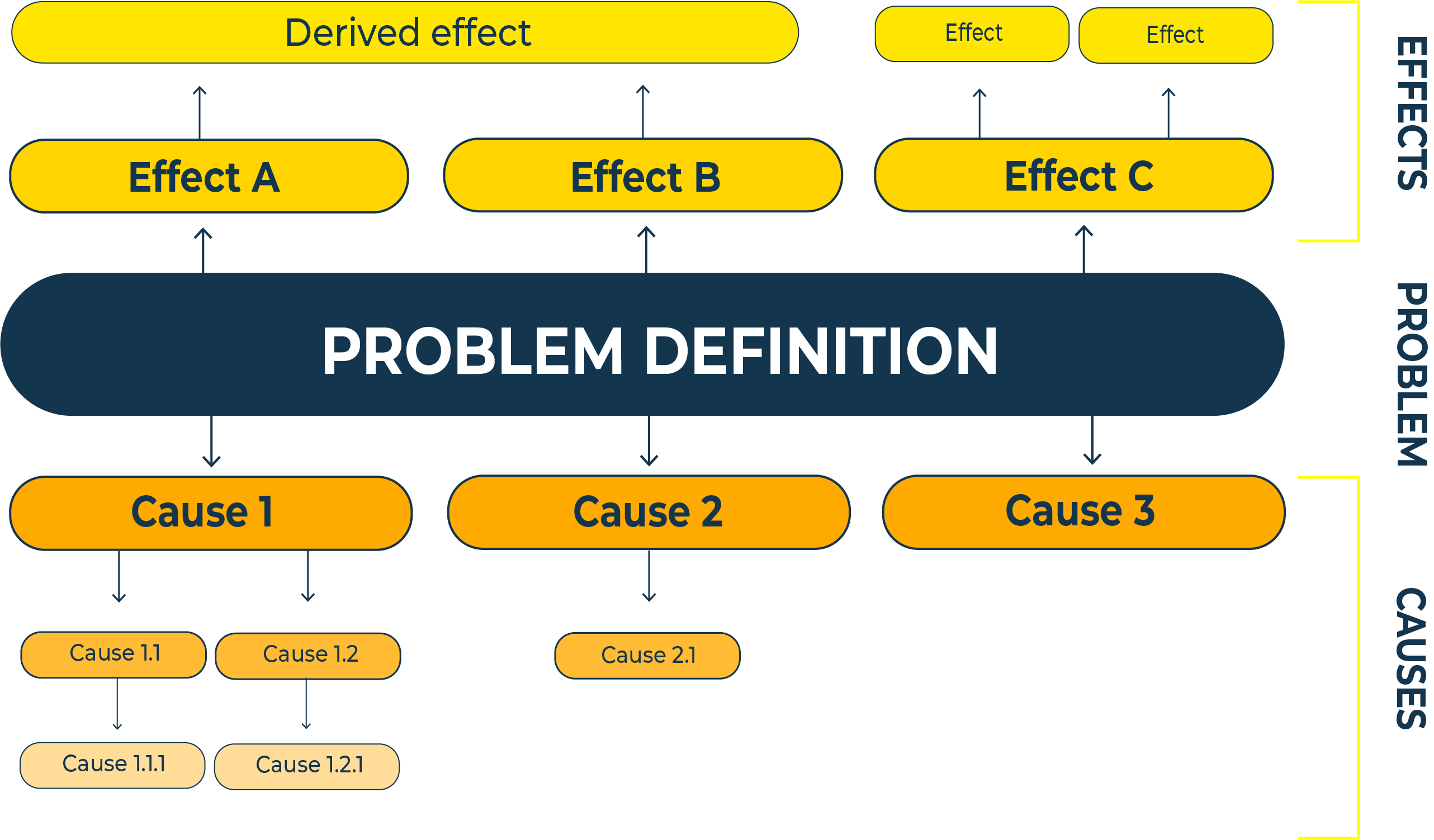The diagnostic stage is fundamental to identify the core problem and the key factors of a problematic situation, which is essential to start the solution design stage. Keep in mind that you must consider any changes you make at this stage in the following stages i.e., adjustments in the diagnosis may impact subsequent stages.
Core problem definition:
The "core problem" is the one that, among the multiple problems that arise within the framework of a problematic situation: a) has the greatest importance of priority, b) can be stated in a specific and comprehensive manner, and c) is measurable
The identified problems must be assigned a priority to determine the central problem. It is important to highlight the strong causality among these identified problems.
The identified problems must be assigned a priority to determine the central problem. It is important to highlight the strong causality among these identified problems.
Once a list of these stakeholders has been completed, it is convenient to categorize them according to:

A common error in specifying the core problem is to express it as a lack or the presence of something negative, for example:
-
Lack of regional anti-drug policy

The problem should be expressed as a negative situation and should be specific and measurable, as it will be verified in light of other sources of information, for example:
-
Psychoactive substance abuse
Key factors
The key factors that allow a better understanding of a problematic situation are its causes, consequences, and the stakeholders involved. The best way to identify them is through the use of the tool called “Problem Tree” and the “Stakeholder Analysis”.
Problem Tree
The Problem Tree is a graphical tool that simplifies the identification of the causes and effects, both direct and indirect, related to a “core problem”. The tree consists of three parts. In the center is the core problem. In the upper segment (“Effects Tree”) are the effects, and in the lower segment (“Causes Tree”) are the causes.

Effects Tree
Once the core problem has been identified, the direct or immediate effects are mapped at the first level, some of which may be interconnected or result in several other effects, following an ascending causal order. If the effects are deemed as important and it is concluded that the problem deserves a solution, the causes that are creating it are up for analysis.
The Effects Tree allows us to demonstrate the existence and estimate the scale of the “core problem”. It graphically represents the different consequences of the problem and how they are related to each other.
Causes Tree
Causes are understood as the set of interrelated factors that produce or generate the problem. The causes of the “core problem” are presented in descending order. In the first line, we find the primary and independent causes that are thought to be creating the problem.
The project must be formulated in such a way as to solve the causes of the problem observed. Accordingly, a suitable problem identification and determining its main cause is fundamental to generating the precise project idea.
In most cases, the sequence of causes follows the following hierarchy:
The direct causes of the problem are specific physical or social conditions.
These conditions are caused by human behavior or, to a lesser extent, by systematic fault.
Human behavior is primarily determined by people's knowledge, attitudes, and beliefs.
People's knowledge, attitudes, and beliefs are based on the context or environment where the target area is located.
The causes of the “core problem” are not always identified in the diagnosis; it is necessary to rely on the literature to support the relationships, i.e., to conduct a state-of-the-art study.
The construction of the Problem Tree: rules, considerations, and recommendations
Rules
To build the Problem Tree it is important to consider the following aspects:
- Avoid cause-effect circularity
- Focus on the main relationship between the levels of causes and effects
- Link the causes of the problem to be addressed
- Prioritize actions/activities
- Define the problem concretely
- Consider public policy limitations
Considerations
The following should be considered, following the USAID’s Problem Diagnosis and Program Design Guidance (2015), that:
The Problem Tree is not a static figure
The Problem Tree is changing
There is no single tree for a phenomenon
Elaborating the Problem Tree is a complex process that requires time and feedback from the work team
Recommendations
When formulating the problem, and identifying its causes and effects, it is critical to carry out a state-of-the-art study and a review of the problem-related literature. Since the problems have already occurred in other contexts, it is useful to explore their main causes and effects and to analyze the solutions that have been implemented. The following are some suggestions for the search for information:
To have systematized information on the program’s target population, the services and/or support provided, the timing of the services, and the program cost, among other aspects.
To make sure that the program has verifiable results, i.e., that it has been evaluated.
To demonstrate the existence of the problem, as well as its causes and effects, it is important to consider different types of information sources, such as:
Public sources
Specific studies
Sources accessible upon request
Own creation






